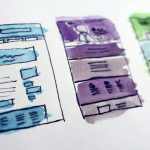Selecting the Ideal Tech Stack is a pivotal decision in USA-based mobile app development projects. It significantly influences the app’s performance, scalability, and development timeline. Here’s a concise guide on how to make this critical choice.
Assess Project Requirements :
Start by thoroughly understanding the project’s objectives and requirements. Consider factors like the app’s complexity, target audience, and desired features.
Native vs. Cross-Platform :
Decide whether to build a native app (iOS and Android separate) or opt for a cross-platform solution like React Native or Flutter. Native apps offer superior performance, while cross-platform tools reduce development time and cost.
Programming Languages :
Choose the programming language that aligns with your selected platform. For iOS, Swift or Objective-C is common, while Java or Kotlin is used for Android.
Development Frameworks :
Depending on your chosen tech stack, identify and utilize suitable development frameworks, libraries, and tools.
Backend Infrastructure :
Select the right backend technology stack (e.g., Node.js, Ruby on Rails, or Django) to ensure seamless data management, security, and scalability.
Database :
Pick a database system (SQL or NoSQL) that suits your app’s data storage and retrieval needs.
Cloud Services :
Consider cloud service providers like AWS, Google Cloud, or Azure for hosting and scaling your app.
UI/UX Design Tools :
Employ design tools and frameworks that streamline the creation of visually appealing and user-friendly interfaces.
Testing and QA :
Implement testing frameworks for robust quality assurance. Automation tools like Appium or XCTest can help ensure app reliability.
Maintenance and Support :
Plan for ongoing maintenance and support, including updates, bug fixes, and enhancements.
Security Measures :
Prioritize security by integrating measures like encryption, authentication, and authorization.
Scalability :
Ensure your tech stack can accommodate future scalability requirements as your user base grows
Why Choose The Best & Right Tech Stack for Mobile App Development?
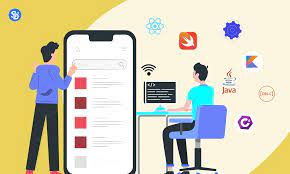
Selecting the Ideal Tech Stack for mobile app development is a critical decision that can significantly impact the success of your project. It involves choosing the right combination of programming languages, frameworks, libraries, and tools to build a high-performance, scalable, and user-friendly mobile app. Here’s why making the right choice is imperative:
Performance :
The Ideal Tech Stack directly affects the app’s speed and responsiveness. Opting for the right tools ensures that your app runs smoothly, loads quickly, and delivers an exceptional user experience.
Scalability :
As your user base grows, your app must handle increased traffic and demand. The Ideal Tech Stack provides scalability options, allowing your app to grow seamlessly without compromising performance.
Development Efficiency :
A well-suited tech stack can streamline the development process, reducing development time and cost. This efficiency is crucial for meeting project deadlines and budget constraints.
User Experience :
The choice of technology impacts the user interface and overall user experience. The the Ideal Tech stack allows you to create a visually appealing and intuitive app that resonates with users.
Maintenance and Updates :
Over time, your app will require maintenance and updates. A well-chosen tech stack makes these tasks more manageable, ensuring your app remains reliable and secure.
Competitive Advantage :
In a competitive app market, choosing the best tech stack can give your app a competitive edge. It allows you to offer features and performance that stand out from the competition.
In conclusion, selecting the best and right tech stack for mobile app development is not just a technical decision; it’s a strategic one. It can impact every aspect of your project, from development speed to user satisfaction. Therefore, investing time and effort into making the right choice is essential for the long-term success of your mobile app.
Selecting the Optimal Technology Stack for Mobile App Development

Choosing the optimal technology stack for mobile app development is a critical decision that can significantly influence the success of your project. Here’s a comprehensive guide to help you make the right choice:
Understand Project Requirements :
Begin by thoroughly understanding the project’s objectives, target audience, and specific requirements. This includes considering factors such as the app’s complexity and desired features.
Native vs. Cross-Platform :
Decide whether you want to develop a native app for each platform (iOS and Android) or opt for a cross-platform solution like React Native or Flutter. Native apps typically offer superior performance and access to platform-specific features, while cross-platform tools can save development time and resources.
Select Programming Languages :
Choose the programming languages that align with your selected platform. For iOS, common choices are Swift or Objective-C, while Java or Kotlin is popular for Android.
Evaluate Development Frameworks :
Depending on your chosen tech stack, identify and assess suitable development frameworks, libraries, and tools. These can significantly impact development speed and code maintainability.
Backend Infrastructure :
Select the right backend technology stack (e.g., Node.js, Ruby on Rails, Django) to ensure seamless data management, security, and scalability.
Database Selection :
Decide between SQL (e.g., MySQL, PostgreSQL) and NoSQL (e.g., MongoDB, Firebase) databases based on your app’s data storage and retrieval needs.
Leverage Cloud Services :
Consider cloud service providers like AWS, Google Cloud, or Azure for hosting, scaling, and managing your app’s infrastructure.
UI/UX Design Tools :
Employ design tools and frameworks that facilitate the creation of visually appealing and user-friendly interfaces.
Prioritize Testing and QA :
Implement testing frameworks and automation tools for rigorous quality assurance to ensure your app functions reliably.
Plan Maintenance and Support :
Develop a strategy for ongoing maintenance and support, including updates, bug fixes, and enhancements.
Security Considerations :
Integrate robust security measures such as data encryption, authentication, and authorization to safeguard user data.
Scalability :
Ensure your chosen tech stack can accommodate future scalability requirements as your user base expands.
By meticulously assessing these factors and aligning your technology stack with your project’s unique needs, you can set the stage for a successful mobile app development endeavour. Making informed decisions during this critical phase can lead to a well-rounded, efficient, and user-friendly mobile app.
Technology Stack For Android Apps
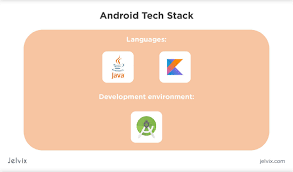
The technology stack for developing Android apps consists of a set of tools, languages, and frameworks that enable developers to create robust and feature-rich applications for the Android platform. Here’s an overview of the key components of the technology stack for Android app development:
Programming Language :
Java and Kotlin are the two primary programming languages used for Android app development. Kotlin, in particular, has gained popularity due to its concise syntax and enhanced safety features.
Integrated Development Environment (IDE) :
Android Studio is the official IDE for Android development. It offers a wide range of tools, including a visual UI designer and debugging capabilities, making it the preferred choice for most Android developers.
Development Framework :
Android developers often use the Android Software Development Kit (SDK), which provides essential libraries, APIs, and tools for building Android apps. Android Jetpack is a collection of libraries that simplifies common tasks and accelerates development.
User Interface (UI) Design :
For UI design, developers use XML layouts and Android’s layout editor within Android Studio. Additionally, Material Design guidelines help create visually appealing and user-friendly interfaces.
Backend Development :
Android apps often require server-side components. Developers can choose from a variety of backend technologies such as Node.js, Ruby on Rails, or Django, depending on their project requirements.
Database :
SQLite is the default database for Android apps. However, developers can integrate other databases like MySQL or Firebase Realtime Database for more extensive data storage and retrieval needs.
Version Control :
Developers use version control systems like Git to manage code changes, collaborate with team members, and track project history.
Testing and Debugging :
Android Studio provides robust testing and debugging tools, including emulators and real device testing capabilities. Automated testing frameworks like Espresso and JUnit are commonly used.
App Distribution :
To distribute apps, developers utilize the Google Play Store, where they can publish and update their apps for Android users worldwide.
Security Measures :
Developers must implement security practices such as data encryption, secure API communication, and user authentication to protect user data and the app’s integrity.
Performance Optimization :
Techniques like code optimization, image compression, and background processing are applied to ensure app performance and responsiveness.
Choosing the right components within this technology stack depends on the specific project requirements and objectives. The flexibility and extensive toolset available for Android app development make it possible to create a wide range of applications, from simple utility apps to complex, data-driven solutions.
Technology Stack For iOS Apps
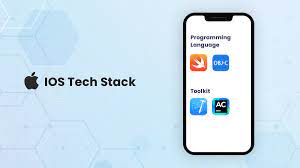
The Ideal Tech Stack for iOS app development comprises a set of tools, languages, and frameworks specifically tailored to create high-quality applications for Apple’s iOS platform. Here’s an overview of the key components of the technology stack for iOS app development:
Programming Languages:
Swift: Swift is Apple’s modern and preferred programming language for iOS app development. It offers safety, performance, and readability, making it the primary choice for most iOS developers.
Objective-C: While Swift has become dominant, Objective-C is still used, especially in maintaining older iOS applications.Integrated Development Environment (IDE) :
Xcode: Xcode is the official IDE for iOS development. It provides a comprehensive suite of tools, including an interface builder, code editor, debugging, and performance analysis tools.
Development Frameworks :
iOS SDK: The iOS Software Development Kit (SDK) includes a vast library of APIs and tools that enable developers to access and utilize iOS device features like touch controls, sensors, and more.
UIKit: UIKit is a framework for building the user interface of iOS apps. It includes essential components like views, view controllers, and user interface controls.
SwiftUI: SwiftUI is a newer framework that simplifies and streamlines the UI development process using a declarative syntax. It is gaining popularity for building modern iOS interfaces.User Interface (UI) Design :
Developers use Interface Builder within Xcode to create and design the UI components visually.
Apple’s Human Interface Guidelines (HIG) help maintain a consistent and user-friendly design language for iOS apps.Backend Development :
Backend technologies for iOS apps can include Node.js, Ruby on Rails, Django, or other server-side technologies, depending on project requirements.
Database :
iOS apps often use Core Data, Apple’s native framework for data storage and management. Alternatively, developers can integrate external databases or cloud-based solutions.
Version Control :
Git is commonly used for version control to manage code changes, collaborate with team members, and track project history.
Testing and Debugging :
Xcode provides a robust suite of testing and debugging tools, including the iOS Simulator and real device testing.
XCTest and third-party testing frameworks are used for unit and UI testing.Security Measures :
Developers must implement iOS security best practices, such as secure data storage, secure communication (HTTPS), and user authentication, to protect user data and app integrity.
Performance Optimization :
Techniques like code optimization, image compression, and background task management are employed to ensure app performance and responsiveness.
The iOS app development stack offers a robust and comprehensive set of tools and frameworks, enabling developers to create innovative and user-friendly applications for iPhones, iPads, and other Apple devices. The choice of specific components within this stack depends on the project’s requirements and objectives.
Technology Stack For Cross-Platform Apps
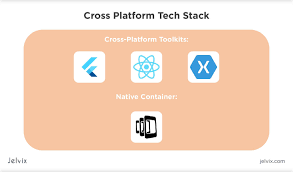
Cross-platform app development allows developers to create applications that can run on multiple platforms, such as iOS, Android, and web, using a single codebase. To achieve this, developers rely on specific technology stacks designed for cross-platform development. Here’s an overview of the key components of the Ideal Tech stack for cross-platform app development:
Programming Languages :
JavaScript : JavaScript is the primary language used for cross-platform app development. Developers write code in JavaScript, which is then executed using a runtime environment.
Frameworks and Libraries :
React Native: Developed by Facebook, React Native is a popular JavaScript framework for building cross-platform mobile apps. It allows developers to create native-like user interfaces using a single codebase.
Flutter: Created by Google, Flutter is an open-source UI toolkit for building natively compiled applications for mobile, web, and desktop from a single codebase. It uses the Dart programming language.
Xamarin: Owned by Microsoft, Xamarin allows developers to build cross-platform apps using C# and the .NET framework. It offers a wide range of pre-built UI components.
Ionic: Built on top of Angular and using web technologies like HTML, CSS, and JavaScript, Ionic is a popular framework for developing cross-platform mobile apps with a native look and feel.Integrated Development Environment (IDE) :
The choice of IDE may vary depending on the framework used. For example, Visual Studio Code is a popular choice for React Native and Flutter development.
User Interface (UI) Design :
Each framework provides its own tools and libraries for designing the user interface. For instance, React Native uses JSX, Flutter uses its own widget system, and Ionic leverages web-based UI components.
Backend Development :
Backend technologies for cross-platform apps can include Node.js, Ruby on Rails, Django, or other server-side technologies, depending on project requirements.
Database :
Developers can choose from a variety of databases based on their backend technology stack, including SQL and NoSQL databases or cloud-based solutions.
Version Control :
Git is commonly used for version control to manage code changes and collaborate with team members.
Testing and Debugging :
Each framework offers its own set of testing and debugging tools. Additionally, cross-platform app development often involves using tools like Appium or Detox for automated testing.
App Distribution :
Cross-platform apps can be distributed through platform-specific app stores (e.g., Apple App Store, Google Play) or as Progressive Web Apps (PWAs) accessible through web browsers.
Security Measures :
Developers must implement security best practices to protect user data and app integrity, regardless of the chosen framework.
Performance Optimization:
Techniques like code optimization, image compression, and efficient data fetching are employed to ensure app performance and responsiveness on various platforms.
The choice of a the Ideal Tech stack for cross-platform app development depends on project requirements, team expertise, and desired platform coverage. Cross-platform frameworks provide a flexible and efficient way to reach a wide audience with a single codebase, reducing development time and effort.
FAQ’S
1. What is a technology stack in mobile app development?
A technology stack is a combination of programming languages, frameworks, libraries, and tools used to build a mobile app. It determines how the app functions, its performance, and the development process.
2. Why is selecting the right tech stack important for a mobile app project?
The right tech stack ensures that your app performs well, is scalable, and meets your project’s specific requirements. It can also impact development time, cost, and the overall user experience.
3. How do I assess my project’s requirements to choose the right tech stack?
Begin by understanding your project’s objectives, target audience, and desired features. Consider factors like app complexity, platform preferences (iOS, Android, or cross-platform), and scalability needs.
4. What are the key considerations when choosing between native and cross-platform development?
Native development offers better performance and access to platform-specific features but may take longer to develop and maintain. Cross-platform development is faster and cost-effective but may have some limitations.
5. Which programming languages are commonly used for mobile app development?
For iOS, Swift and Objective-C are common. For Android, Java and Kotlin are popular. Cross-platform development often uses JavaScript, Dart, or C# depending on the framework.







